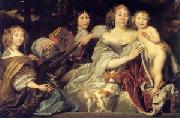
Öl auf dem Segeltuch,das echte Aroma von alten Meistern
|
Abraham van den Tempel
|
|||
|
|
|||

|
|||
Albertine Agnes von Oranien Nassau
Gemälde IDENTIFIZIERUNG:: 84329 new25/Abraham van den Tempel-635797.jpg Öl auf Leinwand, Fries Museum, Leeuwarden cyf Siehe Galerie in Schweden |
|||
|
|
|||
|
|
|||
| (1622 - 1672) was a Dutch Golden Age painter. He probably learned painting from his father, also a painter, but who died when he was still quite young, in 1636. That is the same year that he moved to Amsterdam, where he stayed until 1647, whereupon he moved to Leiden. According to Houbraken he was the son of a Mennonite preacher in Leeuwarden who was a respected art teacher. His father was Lambert Jacobsz (or Jacobszoon), who had taught Govert Flinck and Jacob Adriaensz Backer in their youth, both of whom were artists from Mennonite families. Abraham took the name Tempel because when he studied in Leiden, he lived in a house there with a relief of a Tempel in the keystone. He became a pupil of Jacob Backer, and studied mathematics at Leiden University. He met with great success with the Leiden city council, earning several generous commissions, including a series of three large allegorical paintings on the cloth industry of Leiden for the Cloth Hall which still hang in their original place today in the Stedelijk Museum De Lakenhal. Sir William Davidson of Curriehill, Conservator of the Cloth Staple at Veere (with his son Charles), 1664.He became master of the Guild of St. Luke in 1657 and in 1659 he was chartermaster. In 1660 he returned to Amsterdam. His pupils were Frans van Mieris the Elder, Carel de Moor, Michiel van Musscher, Ary de Vois, and Isaac Paling | |||
| Öl auf Leinwand, Fries Museum, Leeuwarden cyf | |||
|
|
|||







